Research: AI plants are resistant to prolonged drought

Will all of Israel turn into a desert due to global warming? A large-scale German-Israeli study reinforces the belief that such a process is not expected, and shows that the Mediterranean vegetation is much more resistant to climate change than previously thought. In a unique study of its kind in the Eastern Mediterranean, the researchers examined the state of the vegetation for nine years in four study plots throughout the country, characterized by different climate conditions: a Mediterranean forest that receives about 800 mm of rain per year, to a desert climate where less than 100 mm falls. M.
At the research stations, they blocked the rainwater from the plants, creating an irrigation regime that simulates conditions of climate change. According to the predictions of climate experts, the researchers, led by scientists from the University of Tübingen, decided to simulate conditions of a continuous drought, and reduced the amount of precipitation by 30%. In other plots, 30% of the natural rainfall was added to the vegetation. The researchers followed one of the plants in the plots for nine years, and were surprised to discover that during this period there were no real changes in the herbaceous vegetation, neither in terms of the amount of plants and their size, nor in terms of the composition of the plant population or its diversity.
"At first we were surprised by the findings, but later we realized that this is a system that developed over thousands of years under conditions of climatic volatility, and changes in the amount of rain similar to those we produced in the experiment," says the head of the Israeli team in the experiment, Prof. Marcelo Sternberg from the Department of Molecular Biology and Plant Ecology at Tel Aviv University. "With this, it cannot be concluded that the vegetation in our region is resistant to climate change. What characterizes such changes is not a change in the average amount of rain, but an increase in the frequency of extreme events. We do not know what the scope of such events will be in Israel, and how they will affect the grazing areas in Israel." The researchers also found no evidence to support the conventional wisdom, according to which, following a prolonged drought, plant populations migrated to areas more comfortable for them.
financing difficulties
In a study published in the journal Nature Communications, the researchers report on the state of the herbaceous vegetation, which serves as a main source of food for animals in pastures. According to Sternberg, many more years of research will be required to reach clear conclusions regarding the effect of a prolonged drought on vigorous vegetation - that is, shrubs and trees. However, the nine years of research that was fully funded by Germany ended three years ago, and since then Sternberg has been struggling to continue funding the research, not with much success. "I finance the continuation of the work from the money and budget of other studies, but no Israeli entity has agreed to finance this study so far," he says. "It is a cost of several tens of thousands of shekels per year to operate the research stations, with a large part of the cost coming from theft of equipment in the field and vandalism."

3 תגובות
It depends on the type of soil, solar radiation, grazing of animals, migration of sand, fires. It seems that if agriculture expands in the Negev Mountains, and in the steppe, the climate will moderate in the south of the country as well. If the plants and animals are given a chance, they will grow stronger. For example, the wild in the picture has undergone genetic adaptation, so that wild animals born In the Negev, they are more similar to the Syrian wild than to the Persian wild.
The Negev is not a single climatic unit,
In the southern Arava, the average rainfall is 25 mm per year,
And as you go north, the average increases
up to about 250 mm on the Kiryat Gat - Ashkelon line,
According to recent years there are more violent incidents (which complement the average),
A lot of rain in a short time does not saturate the soil, therefore the chance of the growth of annual herbaceous plants decreases,
For woody plants - shrubs and trees - 9 years of research are... too little,
Therefore, the conclusions of the study should be taken with a limited guarantee.
The Negev was forested 5000 years ago. There is no plant that can go from 500 mm per year to 100 mm per year. So let's hope the change is only 30%.